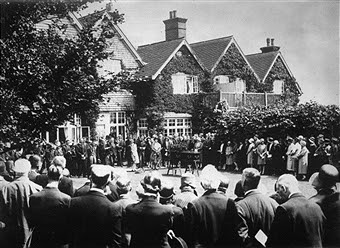While reading about the lives of Rudyard
Kipling and Sir Arthur Conan Doyle, I noticed that they had a few elements in
common in addition to having lived in Southsea - in Kipling's case suffering terribly in the House of Desolation there and in Conan Doyle's case thriving in his doctor's practice.
Artistic fathers
Both men had fathers who illustrated their
books.
Conan Doyle’s father Charles Altamont Doyle
was one of the first artists to depict Sherlock Holmes. His drawings were used
for the 1888 edition of A Study in Scarlet.
John Lockwood Kipling illustrated his son’s
Jungle Books.
Here is an example of each man’s work:
Sherlock Holmes is the tall man in the
middle. I much prefer Sidney Paget’s depiction of the great detective!
Bereaved wives
Both Rudyard Kipling and Conan Doyle married
women they met through the women’s brothers, brothers who both died young.
Conan Doyle met fellow Southsea resident
Louise Hawkins when her brother Jack became a patient of his. He took the young
man into his care at his house in Elm Grove, but the patient soon died. He was
only 25 years old. Dr Doyle and Louise soon became engaged and then married.
Unfortunately, she too died young and Conan Doyle remarried.
Rudyard Kipling met American-born Caroline
Starr Balestier when her brother Wolcott, a writer and publisher who wrote a
book jointly with Kipling, introduced her to his famous friend. Wolcott died
two years later at the age of 29, and Kipling proposed to Caroline soon
afterwards.
Sacrificed sons
Both men were devastated by the loss of their
sons during the First World War.
Conan Doyle’s son Alleyne Kingsley was 25
when he died. An earlier injury had reduced his resistance to the flu epidemic
that killed millions.
Kipling’s son John was 18 years old when he
was killed.
Central London lodgings
Both men lived for a while in a very central
area of London, close to Charing Cross Station.
Conan Doyle spent some time in the now
demolished Morley’s Hotel, where South Africa House now stands; he worked on
The Hound of the Baskervilles while he was staying there.
Kipling took rooms over a music hall in what
is now called Kipling House in nearby Villiers Street. He wrote The Light that
Failed while he was staying there.
Both Conan Doyle’s house in Southsea and his
central London hotel have been demolished; both Rudyard Kipling’s House of
Desolation in Southsea and his central London lodgings are still standing.
Morley’s Hotel before it was demolished:
Kipling House today:
Houses in East Sussex
Both men moved many times in their lives
until they finally settled down, and just as they both found lodgings in
central London, both men found their forever homes in East Sussex.
Conan Doyle moved into a house called
Windlesham on the outskirts of Crowborough, East Sussex in 1907, shortly after
his second marriage. He died in this house in 1930.
Rudyard Kipling moved into Batemans in
Burwash in 1902. He died there in 1936.
Crowborough and Burwash are just 11 miles
apart.
The Brethren
Both men were Freemasons.
Conan Doyle became a Mason in 1887, when he
was 27 years old.
Rudyard Kipling became a Mason in India at
the age of 20.
Conan Doyle doesn’t mention Freemasons in his
autobiographical work Memories and Adventures.
Kipling writes about becoming a Mason in
Something of Myself.
Conan Doyle’s works contain a few, incidental
references to Masons and Masonry.
Masonic Lodges are featured in some of
Kipling’s stories and his works in general are full of Masonic allusions.
Boer War propaganda
Both men publicly declared their support for the British government in the Boer War of 1899 to1902. They thought that the war between Britain and the Boer republics was justified and expressed the wishes of the British people.
While they respected the Boers, they defended Britain’s conduct in South Africa and the treatment of the captives in various jingoistic works. They both highlighted the sufferings of British troops.
Boer War propaganda
Both men publicly declared their support for the British government in the Boer War of 1899 to1902. They thought that the war between Britain and the Boer republics was justified and expressed the wishes of the British people.
While they respected the Boers, they defended Britain’s conduct in South Africa and the treatment of the captives in various jingoistic works. They both highlighted the sufferings of British troops.
Conan Doyle served in South Africa as a
volunteer doctor to the troops, so had first-hand experience of the conflict.
He received his knighthood for a pamphlet he wrote defending British actions
during the war, actions that included burning the Boers’ farms and creating
‘concentration camps’ for Boer women, children and the elderly where many died.
He sent this pamphlet to every man in Europe whose opinion counted.
Kipling became intensely involved in the war.
He was unquestioning, not to say fanatical, in his support of British policies
in southern Africa. He travelled out to South Africa every year from 1900 to
1908. He visited hospitals and worked on a newspaper for the troops.
First World War propaganda
Both men were enlisted to write in support of
the Government’s views and policies in the 1914 – 1918 war in Europe.
When the First World War broke out, Conan
Doyle was one of a number of famous authors who were secretly recruited by the
War Propaganda Bureau to write pro-war propaganda and to promote Britain’s
interests at home and abroad. However, Conan Doyle also used his fame to
campaign on behalf of British soldiers who were “fighting for the freedom of
the world”.
When the British government asked Kipling to
write propaganda in support of the war effort, he jumped at the chance. His
pamphlets and stories painted the British military as the place to become a
hero, fighting for the cause of good against evil, civilization against
barbarism.
It all ended in personal tragedy for both of
them.

















